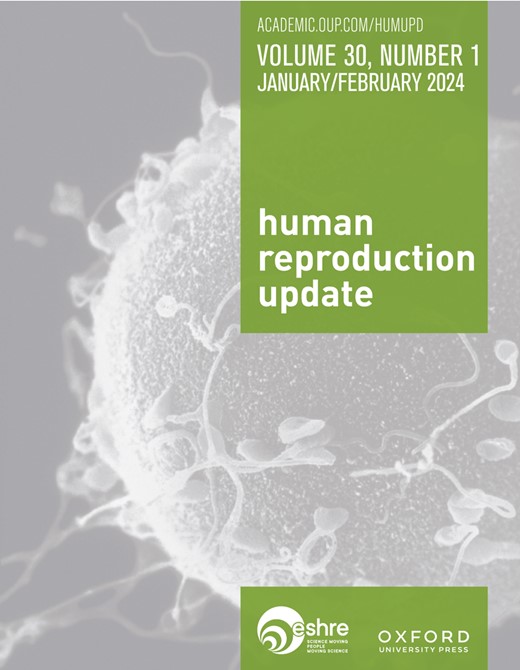过去 10 年父母向捐卵受孕子女披露信息的情况及影响披露信息的因素:叙述性综述
IF 16.1
1区 医学
Q1 OBSTETRICS & GYNECOLOGY
引用次数: 0
摘要
背景 近年来,一些司法管辖区,尤其是那些实行身份解除捐赠的司法管辖区,一直提倡公开捐赠受孕情况。然而,在过去的 10 年中,有关披露决定的研究还没有系统地整合起来,以审查父母是否会告诉子女,以及哪些因素可能会影响他们的决定。目的和依据 在过去 10 年中,父母是否向捐献者所怀子女公开了身份,在不同背景和家庭形式下,哪些因素影响了他们的公开决定?检索方法 对七个数据库中 2012 年至 2022 年间发表的英文同行评审期刊论文进行文献检索。对纳入文章中引用的参考文献进行了人工仔细检查,以确定其他参考文献,同时还对引用纳入文章的参考文献进行了人工检索。纳入标准是,文章重点关注有或没有身份释放规定的司法管辖区中捐赠受孕者的父母(包括异性恋、选择性单亲母亲、同性伴侣和变性人)。仅关注代孕、捐献者、捐献受孕者或医疗/生育工作人员的研究以及无法单独提取捐献受孕者父母数据的研究均被排除在外。定量和定性研究均包括在内。在评估文章质量和偏差时,遵循了《系统综述和元分析首选报告项目》指南,并使用了乔安娜-布里格斯研究所的《系统综述批判性评估工具》。结果 有 37 篇文章符合纳入标准,代表了 34 项研究和 4248 名父母(包括异性恋、单身、同性和变性父母,但大多数为异性恋),他们分别来自匿名捐赠国家和有身份释放规定或随后颁布了这些规定的国家(澳大利亚、比利时、芬兰、法国、香港、中东、西班牙、瑞典、英国和美国)。此外,大多数尚未告知子女的父母都表示计划告知子女,尽管延迟决定也与总体披露率较低有关。与异性父母相比,同性父母和单亲父母更有可能披露信息。人们认识到,披露是一个涉及持续对话的过程,而且决定受到个人内部、个人之间以及外部环境和社会因素的多重影响。研究方法的局限性,如参与者来自不同的人群和环境(包括选择不披露的父母可能不太可能参与研究),在整合研究结果时也得到了承认。更广泛的启示 本综述强化了对理论模型的需求,以解释父母披露信息的决定,并对法律规定、文化和捐赠者/家庭类型在决策中的作用进行研究。为促进父母和家庭的幸福,更多持续获得与披露相关的心理支持可能非常重要。本文章由计算机程序翻译,如有差异,请以英文原文为准。
Parents’ disclosure to their donor-conceived children in the last 10 years and factors affecting disclosure: a narrative review
BACKGROUND Disclosure of donor conception has been advocated in several jurisdictions in recent years, especially in those that practice identity-release donation. However, research on disclosure decisions has not been consolidated systematically in the last 10 years to review if parents are telling and what factors may be impacting their decisions. OBJECTIVE AND RATIONALE Are parents disclosing to their donor-conceived children, and what factors have influenced their disclosure decisions across different contexts and family forms in the last 10 years? SEARCH METHODS A bibliographic search of English-language, peer-reviewed journal articles published between 2012 and 2022 from seven databases was undertaken. References cited in included articles were manually scrutinized to identify additional references and references that cited the included articles were also manually searched. Inclusion criteria were articles focused on parents (including heterosexual, single mothers by choice, same-sex couples, and transsexual) of donor-conceived persons in both jurisdictions with or without identity-release provisions. Studies focused solely on surrogacy, donors, donor-conceived persons, or medical/fertility staff were excluded as were studies where it was not possible to extract donor-recipient parents’ data separately. Both quantitative and qualitative studies were included. Preferred Reporting Items for Systematic Reviews and Meta-Analyses guidelines were followed and Joanna Briggs Institute Critical Appraisal Tools for Systematic Reviews were used to assess article quality and bias. OUTCOMES Thirty-seven articles met the inclusion criteria representing 34 studies and 4248 parents (including heterosexual, single, same-sex, and transsexual parents although the majority were heterosexual) from countries with anonymous donation and those with identity-release provisions or who had subsequently enacted these provisions (Australia, Belgium, Finland, France, Hong Kong, Middle East, Spain, Sweden, the UK, and the USA) A general trend towards disclosure was noted across these groups of parents with most disclosing to their donor-conceived children before the age of 10 years. Further, the majority of those who had not yet told, reported planning to disclose, although delayed decisions were also associated with lower disclosure overall. Same-sex and single parents were more likely to disclose than heterosexual parents. There was recognition of disclosure as a process involving ongoing conversations and that decisions were impacted by multiple interacting intrapersonal, interpersonal, and external contextual and social factors. Methodological limitations, such as the different population groups and contexts from which participants were drawn (including that those parents who choose not to disclose may be less likely to participate in research), are acknowledged in integrating findings. WIDER IMPLICATIONS This review has reinforced the need for a theoretical model to explain parents’ disclosure decisions and research exploring the role of legislative provisions, culture, and donor/family type in decision-making. Greater ongoing access to psychological support around disclosure may be important to promote parent and family well-being.
求助全文
通过发布文献求助,成功后即可免费获取论文全文。
去求助
来源期刊

Human Reproduction Update
医学-妇产科学
CiteScore
28.80
自引率
1.50%
发文量
38
期刊介绍:
Human Reproduction Update is the leading journal in its field, boasting a Journal Impact FactorTM of 13.3 and ranked first in Obstetrics & Gynecology and Reproductive Biology (Source: Journal Citation ReportsTM from Clarivate, 2023). It specializes in publishing comprehensive and systematic review articles covering various aspects of human reproductive physiology and medicine.
The journal prioritizes basic, transitional, and clinical topics related to reproduction, encompassing areas such as andrology, embryology, infertility, gynaecology, pregnancy, reproductive endocrinology, reproductive epidemiology, reproductive genetics, reproductive immunology, and reproductive oncology. Human Reproduction Update is published on behalf of the European Society of Human Reproduction and Embryology (ESHRE), maintaining the highest scientific and editorial standards.
 求助内容:
求助内容: 应助结果提醒方式:
应助结果提醒方式:


